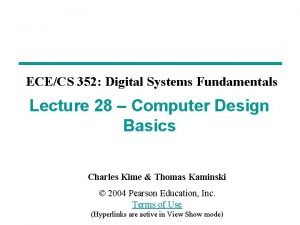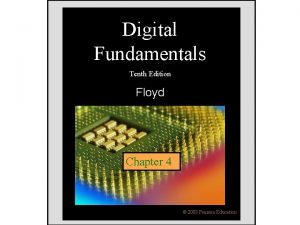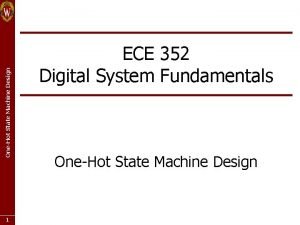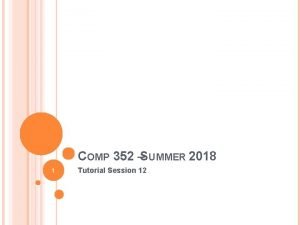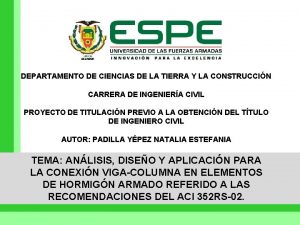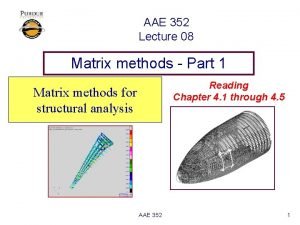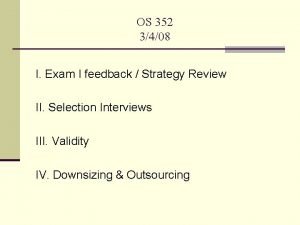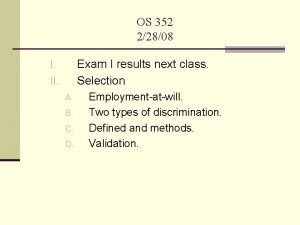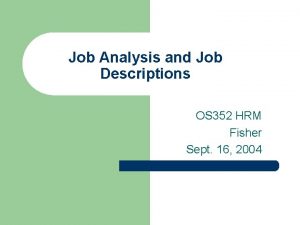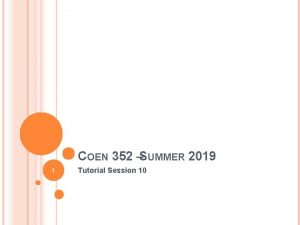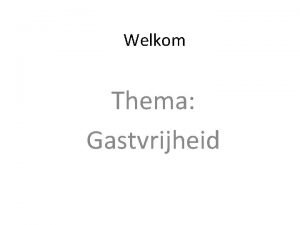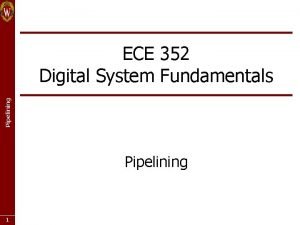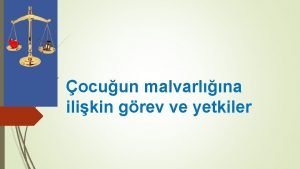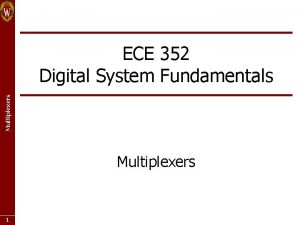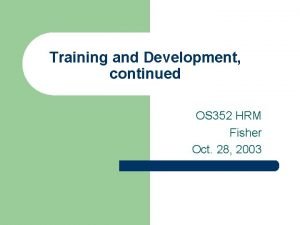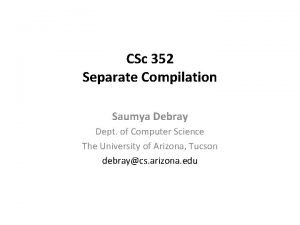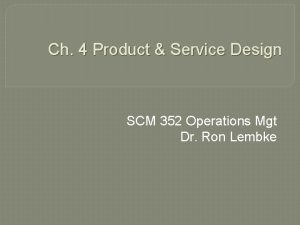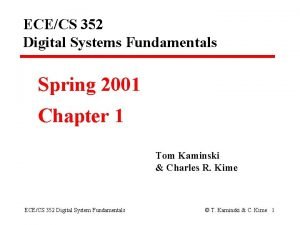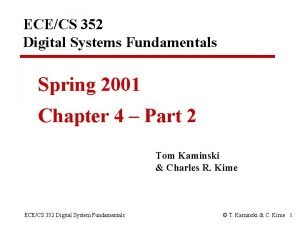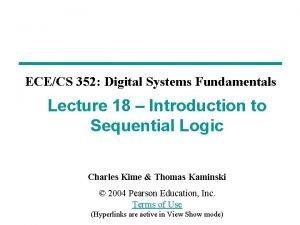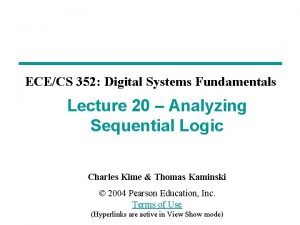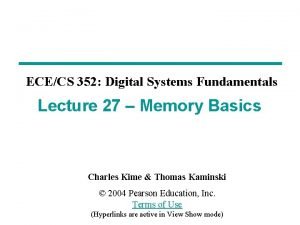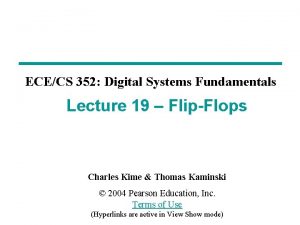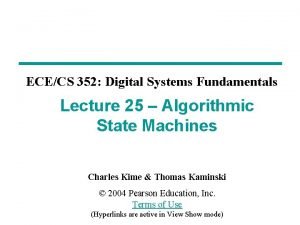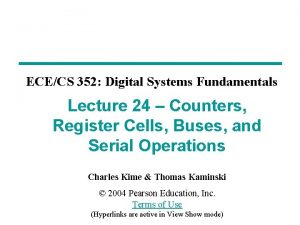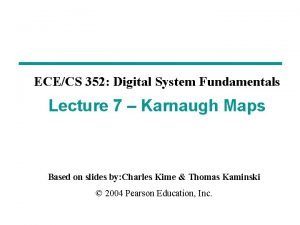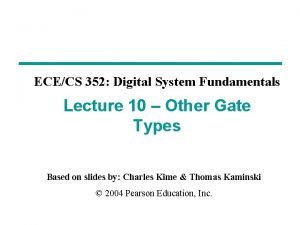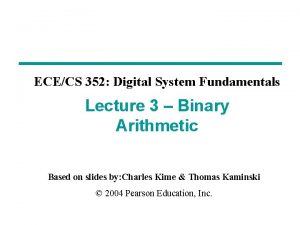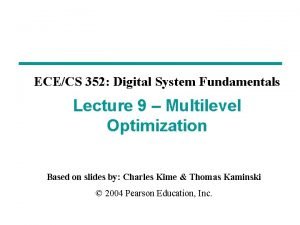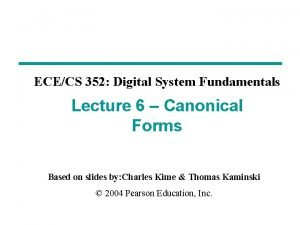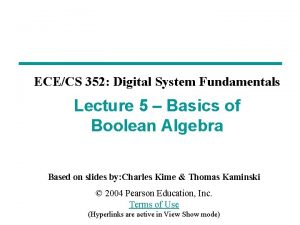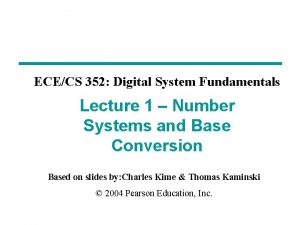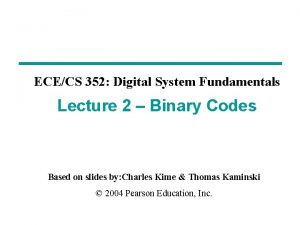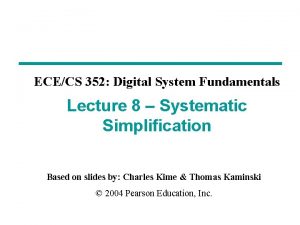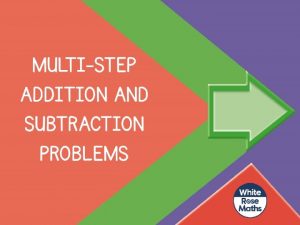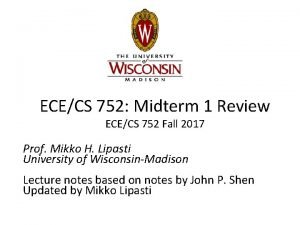ECECS 352 Digital Systems Fundamentals Spring 2001 Chapter























- Slides: 23

ECE/CS 352 Digital Systems Fundamentals Spring 2001 Chapter 2 – Part 5 Tom Kaminski & Charles R. Kime ECE/CS 352 Digital System Fundamentals 1

Three-Variable Maps • Reduced literal product terms for SOP standard forms correspond to rectangles on K-maps containing cell counts that are powers of 2. • Rectangles of 2 cells represent 2 adjacent minterms; of 4 cells represent 4 minterms that form a “pairwise adjacent” ring. • Rectangles can be in many different positions on the K-map since adjacencies are not confined to cells truly next to teach other. ECE/CS 352 Digital System Fundamentals 2

Three-Variable Maps • Topological warps of 3 -variable K-maps that show all adjacencies: § Venn Diagram Cylinder 0 4 X 6 7 5 Y 3 Z 1 2 ECE/CS 352 Digital System Fundamentals 3

Three-Variable Maps • Example Shapes of Rectangles: Y X X Y 0 1 3 2 4 5 7 6 Z ECE/CS 352 Digital System Fundamentals Z Z 4

Three Variable Maps F(x, y, z) = x y+ z ECE/CS 352 Digital System Fundamentals 5

Three-Variable Map Simplification • F(X, Y, Z) = (0, 1, 2, 4, 6, 7) ECE/CS 352 Digital System Fundamentals 6

Four Variable Maps ECE/CS 352 Digital System Fundamentals 7

Four Variable Terms • Four variable maps can have terms of: § Single one = 4 variables, (i. e. Minterm) § Two ones = 3 variables, § Four ones = 2 variables § Eight ones = 1 variable, § Sixteen ones = zero variables (i. e. Constant "1") ECE/CS 352 Digital System Fundamentals 8

Four-Variable Maps • Example Shapes of Rectangles: Y W W Y 0 1 3 2 4 5 7 6 12 13 15 14 X 8 9 11 10 X Z ECE/CS 352 Digital System Fundamentals Z X Z 9

Four-Variable Map Simplification • F(W, X, Y, Z) = (0, 2, 4, 5, 6, 7, 8, 10, 13, 19) ECE/CS 352 Digital System Fundamentals 10

Four-Variable Map Simplification • F(W, X, Y, Z) = (3, 4, 5, 7, 13, 14, 15, 17) ECE/CS 352 Digital System Fundamentals 11

Systematic Simplification • A Prime Implicant is a product term obtained by combining the maximum possible number of adjacent squares in the map. • A is a prime implicant is called an Essential Prime Implicant if it is the only prime implicant that covers (includes) one or more minterms. • Prime Implicants and Essential Prime Implicants can be determined by inspection of the K-Map. • A set of prime implicants that "covers all minterms" means that, for each minterm of the function, there is at least one prime implicant in the selected set of prime implicants that includes the minterm. ECE/CS 352 Digital System Fundamentals 12

Example of Prime Implicants ECE/CS 352 Digital System Fundamentals 13

Prime Implicant Practice • F(A, B, C, D) = (0, 2, 3, 8, 9, 10, 11, 12, 13, 14, 15) ECE/CS 352 Digital System Fundamentals 14

Systematic Approach (No Don’t Cares) 1. Select all Essential PI's 2. Find and delete all Less Than PIs 3. Repeat 1) and 2) until all minterms are covered. If Cycles Occur: 4. Arbitrarily select a PI and generate a cover. 5. Delete the selected PI and generate a new cover 6. Select the cover with fewer literals 7. If a new cycle appears, repeat steps 4), 5), and 6) and compare all solutions for the best. ECE/CS 352 Digital System Fundamentals 15

Other PI Selection ECE/CS 352 Digital System Fundamentals 16

Example 2 from Supplement 1 ECE/CS 352 Digital System Fundamentals 17

Example 2 (Continued) ECE/CS 352 Digital System Fundamentals 18

Another Example • G(A, B, C, D) = (0, 2, 3, 4, 7, 12, 13, 14, 15) ECE/CS 352 Digital System Fundamentals 19

Five Variable or More K-Maps ECE/CS 352 Digital System Fundamentals 20

Don't Cares in K-Maps • Sometimes a function table contains entries for which it is known the input values will never occur. In these cases, the output value need not be defined. By placing a “don't care” in the function table, it may be possible to arrive at a lower cost logic circuit. • “Don't cares” are usually denoted with an "x" in the K-Map or function table. • Example of “Don't Cares” - A logic function defined on 4 -bit variables encoded as BCD digits where the four-bit input variables never exceed 9, base 2. Symbols 1010, 1011, 1100, 1101, 1110, and 1111 will never occur. Thus, we DON'T CARE what the function value is for these combinations. • “Don't cares“are used in minimization procedures in such a way that they may ultimately take on either a 0 or 1 value in the result. ECE/CS 352 Digital System Fundamentals 21

Example: BCD “ 5 or More” ECE/CS 352 Digital System Fundamentals 22

Product of Sums Example • F(A, B, C, D) = (3, 9, 11, 12, 13, 14, 15) + (1, 4, 6) • Use and take complement of result: ECE/CS 352 Digital System Fundamentals d 23
 Ececs
Ececs Digital fundamentals chapter 4
Digital fundamentals chapter 4 Fundamentals of information systems chapter 1
Fundamentals of information systems chapter 1 Fundamental of information system
Fundamental of information system Kim ki duk summer fall winter spring
Kim ki duk summer fall winter spring Summer spring winter fall
Summer spring winter fall Ece 352
Ece 352 It 352
It 352 352 formação
352 formação Comp 352
Comp 352 Union viga columna hormigon armado
Union viga columna hormigon armado Troop 352
Troop 352 Aae 352
Aae 352 Os 352
Os 352 Os 352
Os 352 Os 352
Os 352 Coen 352
Coen 352 Wees stil voor het aangezicht van god
Wees stil voor het aangezicht van god Ece 352
Ece 352 Tmk 352
Tmk 352 Ece 651
Ece 651 Os 352
Os 352 Csc 352
Csc 352 Scm 352
Scm 352
